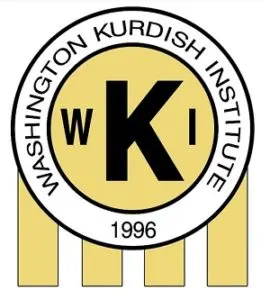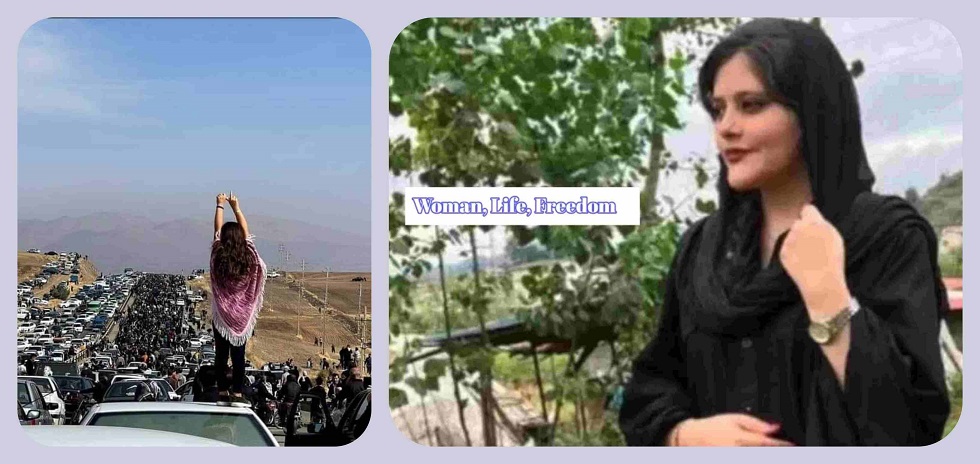Washington Kurdish Institute
November 3, 2022
The recent murder of a Kurdish woman, Zhina Mahsa Amini, is one of many examples of the Kurdish struggle under the 43-year-old Islamic Republic of Iran and, before that, under the Iranian Shah for decades. Amini was arrested by the so-called “morality police” for “improperly wearing Hijab.” After three days in the hospital under custody, she was announced dead. The authorities covered the incident, raising suspicion of torture–a practice often used against civilians.
Amini was a Kurd from the Kurdistan Region of Iran, which is facing harsh crackdowns by the security forces, including killing civilians, arresting activists, blocking internet access, and imposing curfews and material laws on Kurdish cities and towns. Amini’s Kurdish is relevant to a nation struggling for freedom for a century. Little is known about the Iranian Kurds, who compose 10 -12 million people, native to western Iran, and the east part of greater Kurdistan known as Rojhelat.
In 1979, the Kurdish Region boycotted the referendum staged by the Mullahs to establish an Islamic regime. Since then, they have faced various persecutions by the regime, from execution to imprisonment, preventing cultural and political rights. Like other Kurdish regions in Syria, Turkey, and Iraq (before 2003), Rojhelat is one of Iran’s poorest, underdeveloped regions due to discriminatory policies.
The Iranian regime executed dozens of Kurdish dissidents. Currently, the only woman on death row in Iran is a Kurdish political prisoner named Zeynab Jalalian. “Ministry of Intelligence agents are torturing Iranian Kurdish woman Zeynab Jalalian by deliberately denying her health care to coerce her into providing a videotaped “confession.” This intentional denial of health care is causing her severe pain and suffering, particularly as she has serious medical conditions, including post-Covid-19 breathing difficulty.” Reported by Amnesty International.
Even before the ongoing protests, the Ministry of Intelligence (Ettela’at) was arresting dozens of civilian activists yearly. Many human rights, environmental, political, and cultural activists face long prison times. Among the victims is Zara Mohammadi, a Kurdish woman, educator, and teacher of her mother tongue, who’s behind bars after being sentenced to five years. Mohammadi’ was accused of “forming groups” against the regime, a baseless charge highlighting the injustice in Iran. “The Kurds face a disproportionate amount of repression from the regime. We know that roughly half the political prisoners and executions in Iran are Iranian Kurds when they are less than 10% of the population,” said professor David Romano of Middle East Politics at Missouri State University.
Kurds are mainly Sunnis, making them a double minority in the eyes of the sectarian regime in Tehran. “Most of them are Sunni as well. So, they’re double minorities in a sense from the regime’s perspective, and whatever the infraction, one can imagine that if the person facing the regime is Kurdish, the reaction is more severe even now in the protests, following her death,” added Romano.
The Iranian Kurds have been the most vocal and active against the regime, demonstrating injustice and resisting oppression. They are the most organized and easy to mobilize against the authorities. Soon after Amini’s death, the Kurds rose, starting from Amini’s hometown Saqqez, and expanded the protests across the Rojhelat and later nationwide. The theme slogan for the demonstrators was “Woman, Life, Freedom” which translated into Persian as well. “She has been the center of the protest movement ever since it started. Interestingly, the protest turned into a unifying factor for the entire Iran, and not only the Kurds,” said Ceng Sagnic, an expert on Kurdish and Turkey affairs, during a webinar on Rojhelat hosted by the Washington Kurdish Institute (WKI). The current protests have continued since September 16 across the country, unlike previous demonstrations where intense authorities’ crackdown halted it. “The protest movement of 2022 differs from previous protest movements in Iran in several aspects. The first is: this is one of the largest that Iran has seen, perhaps the largest since 2009. But the biggest difference is that the protest movement of today has no unified or centralized leadership, or doesn’t have any leader symbols or previous movements in Iran ever since the revolution took place in 1979,” added Sagnic.
“Previously, we didn’t have this close cooperation among Iranian ethnic groups. We saw very common slogans around Iran. We saw, for the first time since 2009, the return of university students,” said Salah Bayaziddi, the representative of the Komala party of Iranian Kurdistan in Washington. Bayaziddi addressed how conservative Iranians have risen against the regime. “They’re burning the security forces’ vehicles in Mashhad, the city of Khomeini! Or the city of Kerman, which just three years ago was the center of the funeral for Qassim Soleimani.” Bayazidde acknowledges that women are leading the movement, but other components of Iran also support it. “More importantly, women are at the forefront of this struggle. So we are going through this very new phase of the revolution in Iran,” said Bayaziddi.
Amini’s case demonstrates the ill laws established by the Mullahs, aiming to strip women further of simple rights. “She was arrested for failing to cover her hair modestly in accordance with the hijab law, a relic of the Islamic Revolution that was adopted in 1981 and is still used by conservative clerics to justify their militant male theocracy,” said David L. Phillips, the Director of the Program on Peace-building and Human Rights at Columbia University. The Iranian misogynistic regime has promoted patriarchal ruling such as a travel ban on women unless accompanied by a husband or a male “guardian.” “Laws that grant men exclusive custody of children, rules that allow polygamy for men. They’re [the Iranian regime] opposing laws that lower the marriage age for girls and require women to get permission from their husbands or fathers to travel,” noted Phillips.
The Kurdish question in Iran dates to centuries, as Iran controlled the second-largest Kurdish region in the Middle East while Turkey, under the Ottomans, occupied most of Kurdistan. But unknown to many, modern Iran was built on the lands of several ethnic groups, including Persians being the majority, followed by Azeris, Kurds, Arabs, Balochis, Bakhtyari, Lurs, Tats, and several religious minorities. Most ethnic groups have advocated for self-determination or a decentralized system, given that the Iranian central government has deprived minorities of fundamental rights throughout history. However, among the minorities, the Kurdish parties are the most experienced, given they are the oldest case. The opposition parties, including the Kurds, have been exiled in the dictatorial system since 1979.
The Iranian Kurds declared their own republic in 1946 under the leadership of the Kurdish leader Qazi Mohammed. However, due to international agreement to back the central government in Iran, mainly by the western powers, the red army withdrew its support for the republic, ending the self-ruling of the Kurds. Today, several Kurdish parties exiled to Iraq have formed the Cooperation Center for Iranian Kurdistan’s Political Parties (CCIKP). Its main tasks are coordination of struggle and decreasing division among the Kurds. The Iranian Kurdish parties are in a semi-consensus of how future Iran, post this current regime, should shape. “The cooperation center adopted a joint statement this summer that was endorsed by the Democratic Party of Iranian Kurdistan, the Kurdistan Democratic Party of Iran, and the Komala Party of Iranian Kurdistan. The statement embraced federalism as the most effective power-sharing system and enshrining the rule of law. Signatories reject Iran’s centralization and concentration of power,” said Phillips, who worked with the Kurdish parties to draft a paper on Iran’s future.
Since the start of the protests was in the Kurdish Region first, the Iranian regime has repeated its rhetoric to blame the “foreign powers” and the Kurdish “spiritists” attempting to divide Iran. The rallying around the flag is a tactic often used by autocrats. “Definitely. The Kurdish political parties have supported the movement. Kurdish political parties have played a role in mobilizing and organizing people. But this issue is that uprisings are not something that Kurdish political parties wanted to orchestrate in the whole of Iran,” said Arash Saleh, the representative of the Democratic Party of Iranian Kurdistan (KDPI) in Washington. But the existential threats by the demonstration troubled the Iranian authorities. In intolerance of peaceful rallies in Iran, the Islamic Revolutionary Guards (IRGC) launched attacks on the Kurdish parties’ headquarters in Iraqi Kurdistan. The IRGC missiles and drones killed dozens of people and wounded at least fifty Kurdish refugees who fled Iran, residing in Iraqi Kurdistan since 1979. “[Iranian president] Raisi and the IRGC are trying to solve a problem by creating a bigger one. Iranians of all ethnicities, men and women alike, find violence to be intolerable. They want a genuine political transition in Iran towards a federal parliamentary democracy. If the regime stands in the way, then the regime should be removed.” said Phillips.
The ongoing demonstrations is more shaped as a peaceful revolution. It has continued its momentum of aiming for change while expanding to even more suburbs and small towns. Zhina Mahsa Amini was a Kurd, like many others, who had become a symbol of freedom. However, the accumulated issues in Iran since 1979, including repressive policies, and poor living conditions for decades, have united all Iranians to stand against the Mullahs and voice liberty—Woman, Life, Freedom.

